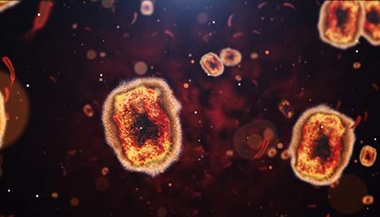Toxic Shock Syndrome (TSS)
What is toxic shock syndrome?
Toxic shock syndrome (TSS) is a cluster of symptoms that involves many systems of the body. Certain bacterial infections release toxins into the bloodstream, which then spreads the toxins to body organs. This can cause severe damage and illness.
What causes toxic shock syndrome?
The following bacteria commonly cause TSS:
- Staphylococcus aureus
- Streptococcus pyogenes
- Clostridium sordellii
TSS from Staphylococcus infections was identified in the late 1970s and early 1980s when highly absorbent tampons were widely used by menstruating women. Due to changes in how tampons are made, the incidence of tampon-induced TSS has declined.
TSS from streptococcus infections is most commonly seen in children and the elderly. Other people at risk include those with diabetes, weak immune system, chronic lung disease, or heart disease.
- Staphylococcus infections. Staphylococcus aureus (or S. aureus) may normally exist on a person's body and does not cause infection. Because it's part of the body's normal bacteria, most people develop antibodies to prevent infection. S. aureus can be spread by direct contact with infected persons. People who develop TSS usually have not developed antibodies against S. aureus. Therefore, it's not usually considered a contagious infection. S. aureus infections may also develop from another infection, such as pneumonia, sinusitis, osteomyelitis (infection in the bone), or skin wounds, such as a burn or surgical site. If any of these areas are infected, the bacteria can penetrate into the bloodstream.
- Streptococcus infections. Streptococcus pyogenes (or S. pyogenes) TSS may occur as a secondary infection. Most commonly, this is seen in people who have recently had chickenpox, bacterial cellulitis (infection of the skin and underlying tissue), or who have weak immune systems.
- Clostridium sordellii infections. Clostridium sordellii (or C. sordellii) normally exists in the vagina and does not cause infection. The bacteria may enter the uterus during normal menstruation, childbirth, or gynecological procedures such as abortion. Intravenous drug use can also cause C. sordellii infections.
Who is at risk for toxic shock syndrome?
The following are risk factors for toxic syndrome:
- History of using super-absorbent tampons
- Surgical wounds
- A local infection in the skin or deep tissue
- History of using the diaphragm or contraceptive sponge
- History of recent childbirth, miscarriage, or abortion
What are the symptoms of toxic shock syndrome?
Symptoms of TSS involve many systems and may look like other infections. While each person may experience symptoms differently, the following are the most common symptoms of staphylococcal TSS:
- Fever higher than 102°F (38.9°C)
- Chills
- Feeling unwell
- Headache
- Fatigue
- Rash that is red and flat and that covers most of the areas of the body
- Shedding of the skin in large sheets, especially over the palms and soles, seen one to two weeks after the onset of symptoms.
- Low blood pressure
- Vomiting
- Diarrhea
- Muscle pain
- Increased blood flow to the mouth, eyes, and vagina, making them appear red
- Decreased urine output and sediment in urine
- Decreased liver function
- Bruising due to low blood platelet count
- Disorientation and confusion
The following are the most common symptoms of streptococcal TSS:
- Dangerously low blood pressure
- Shock
- Decreased kidney function
- Bleeding problems
- Bruising due to low blood platelet count
- Rash that is red and flat and that covers most of the areas of the body
- Liver impairment
- Shedding of the skin in large sheets, especially over the palms and soles (this does not always occur)
- Difficulty breathing
The following are the most common symptoms of C. sordellii TSS:
- Nausea and/or vomiting
- Lethargy
- Flu-like symptoms
- Abdominal tenderness
- Generalized swelling from fluid buildup
- High white blood cell and red blood cell count
- No fever
- Low blood pressure
- Very fast heart rate
How is toxic shock syndrome diagnosed?
Ruling out similar illnesses (such as Rocky Mountain spotted fever, among others) is critical in diagnosing TSS. Other diagnostic tests may include:
- Blood cultures. Tests used to find and identify microorganisms.
- Blood tests. Tests to measure blood clotting and bleeding times, cell counts, electrolytes, and liver function, among others.
- Urine tests.
- Lumbar puncture. A procedure involving the insertion of a needle in between the vertebrae of the spine to draw spinal fluid and check for bacteria.
How is toxic shock syndrome treated?
Specific treatment will be determined by your health care provider based on:
- Your age, health, and medical history
- Extent of the disease
- Your tolerance for specific medications, procedures, or therapies
- Expectations for the course of the disease
- Your opinion or preference
Treatment for TSS may include:
- Giving intravenous (through a vein) antibiotics
- Giving intravenous fluid to treat shock and prevent organ damage
- Heart medications in people with very low blood pressure
- Dialysis may be required in people who develop kidney failure
- Giving blood products
- Supplemental oxygen or mechanical ventilation to assist with breathing
- Deep surgical cleaning of an infected wound
What are the complications of toxic shock syndrome?
TSS can result in amputations of fingers, toes, or limbs, or even death.
Can toxic shock syndrome be prevented?
- Since reinfection is common, menstruating girls and women should avoid using tampons if they have had TSS.
- Prompt and thorough wound care is crucial in avoiding TSS.
- Minimal usage of vaginal foreign body items, such as diaphragms, tampons, and sponges can also help prevent TSS.
When should I call my health care provider?
TSS may start like other infections, but it can quickly progress to a seriously life-threatening disease. If a mild illness quickly becomes severe with whole-body symptoms, seek immediate medical attention.
Key Points about Toxic Shock Syndrome
- Toxic shock syndrome describes a cluster of symptoms that involve many systems of the body.
- It can be caused by Staphylococcus aureus, Streptococcus pyogenes, or Clostridium sordellii.
- Early symptoms are similar to other infections but can progress quickly to become life-threatening.
- TSS can be life-threatening and requires immediate medical attention.
Next Steps
Tips to help you get the most from a visit to your health care provider:
- Before your visit, write down questions you want answered.
- Bring someone with you to help you ask questions and remember what your provider tells you.
- At the visit, write down the names of new medicines, treatments, or tests, and any new instructions your provider gives you.
- If you have a follow-up appointment, write down the date, time, and purpose for that visit.
- Know how you can contact your provider if you have questions.




